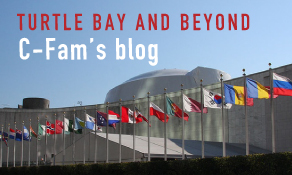Five Problems with the UN Cybercrime Treaty
On August 8, 2024, an ad hoc committee of the General Assembly for the elaboration of a UN cybercrime treaty completed its work by adopting a draft text of the convention.[1] Articles 14, 15, and 16 of the new treaty allow for the creation of simulated and virtual child pornography and sexting, which is child pornography consensually created by consenting minors for private consumption. These provisions are not only loopholes for predators but also hurdles to prosecutors. They run counter to the criminal standards already developed to prosecute predators who produce, distribute and consume child pornography for the last thirty years.
The treaty is expected to be formally adopted by the General Assembly before the end of 2024 and will be open for signatures by countries. It will enter into force after forty countries ratify it.
1. The new treaty on crimes against humanity expressly allows for the creation, distribution, and possession of certain forms of child pornography.
The treaty expressly establishes that states who ratify the treaty “may” allow some forms of child pornography.[2] According to article 14.2 governments may choose to decriminalize the production, distribution, and possession of sexualized visual, written or audio content depicting children, so long as they do not represent an “existing person” or do not “visually depict child sexual abuse or child sexual exploitation.”[3] Articles 14.4 and 15.4 explicitly provide that States may exclude the criminalization of sexting by children under any and all circumstances as well as sexting by a child to an adult when the child is above age of consent and the sexting is only private behavior.[4] Articles 14.1 and 16.5 of the treaty moreover add a specific intent requirement as to all the elements of the crime.[5] The criminal intent requirement makes it harder to prosecute many cases of possession or distribution.
2. The new treaty conflicts with the broad definition of child pornography and the strict standard for prosecuting child pornography in federal and international law.
Federal law has a broad definition for child pornography that allows prosecutors to aggressively investigate and prosecute predators. The mere appearance of child pornography creates a presumption of criminal liability.[6] There is no need to prove an underlying crime of child sexual abuse for child pornography to be prosecuted. It is enough for the pornographic material to have the appearance of child pornography for it to be prosecutable, including virtual child pornography.[7]
These broad definitions and the same strict standards from federal law were enshrined in the Optional Protocol of the Convention on the Rights of the Child on the sale of children, child prostitution and child pornography.[8] This binding international treaty was promoted and ratified by the U.S. government to help prosecute child pornography world-wide. Article 2 of the treaty defines child pornography broadly as “any representation, by whatever means, of a child engaged in real or simulated explicit sexual activities or any representation of the sexual parts of a child for primarily sexual purposes.”[9] The treaty further requires prosecution for the production, distribution, and possession of child pornography.
3. The new treaty makes it impossible to prosecute many cases of child trafficking.
When child pornography became a major law enforcement challenge in the 1970s, it rapidly became clear that the only way to effectively fight child pornography would be to adopt a broad definition of child pornography and a strict standard for prosecuting the production, distribution, and possession of child pornography. There is no other way to fight this kind of harmful material. Once images are created and distributed widely through the internet, it becomes nearly impossible to establish a connection to the original sexual abuse. Moreover, it was always apparent that if virtual child pornography would be tolerated in any way, it would fuel demand for real child pornography and eventually lead to more children being abused. Any loophole or caveat to a broad definition and a strict standard for prosecution would make it too difficult to prosecute perpetrators.
The exceptions in the treaty are blunt and overbroad. They hinder the ability of public authorities to prosecute criminals in line with their obligations under the Optional Protocol of the Convention on the Rights of the Child. Allowing the blanket decriminalization of self-generated child pornography by consenting minors is especially dangerous.
Groomers and traffickers make use of children to generate an endless supply of child and adult pornography. This is precisely the criminal organization model of the notorious Romanian social media personality Andrew Tate.[10] Public Prosecutors must have the ability to threaten with prosecution minors implicated in trafficking rings and criminal networks. Criminal liability is a tool to end impunity and protect children. It gives prosecutors leverage to go after the adult criminals but allows discretion in the prosecution of minors depending on their level of culpability. This is standard law enforcement practice when adults use minors in criminal networks. Children otherwise protect their adult co-conspirators.
4. The new treaty makes it impossible for cross-border cooperation by law enforcement between those countries that criminalize the production of child pornography by minors and those that have exceptions.
The conflict of laws between countries that continue to enforce the definitions and standards in the Optional Protocol on the Convention on the Rights of the Child and those that implement the new standards and definitions of the new cybercrime treaty will leave children unprotected. The conflict of laws will make it harder for law enforcements to cooperate across borders and will allow child sex abusers and criminal pornographers impunity. Allowing children to self-generate sexual content especially will create an impossible conflict of laws across borders. Once child pornography is generated legally in one country, what happens when it is shared across borders? If an underage girl from Africa or the Middle East produced sexual content and shared it across borders with someone in Europe, whose laws would apply?
5. The production of self-generated and virtual sexual materials depicting children will fuel demand for child pornography and child sexual abuse material.
There is an utter lack of contextual competency in the exceptions crafted in the treaty. The exceptions to criminal liability in Articles 14.3 and 14.4 that allow the production of self-generated and virtual sexual materials depicting children will fuel demand for “real” child pornography and child sexual abuse material. If we allow children to consensually produce and share self-generated sexual images or programmers to create virtual child pornography it will create an endless supply of new child pornography and child sexual abuse material. This will only embolden perpetrators to hurt more children. It is a well-established fact that pornography fuels perversion, violence against women, and sex trafficking. In the same way, virtual child pornography and self-generated child pornography will embolden child predators. It is irresponsible and immoral to presume that sexual deviants will stop at virtual child pornography and self-generated child pornography. They will inevitably graduate to worse and more explicit forms of child pornography, and this will in turn fuel more child exploitation and sex trafficking.
Conclusion
Sovereign States should not ratify or join the cyber-crime treaty because it undermines efforts to combat child pornography.
Children should not have to bear the burden of having to protect themselves from exploitation on online technology platforms. The loopholes in the draft treaty are a boon for the worst sex abusers and sexual deviants. They will have access to an endless stream of legally generated real and virtual child pornography that will lead to the sexual exploitation of more children. This is unacceptable. The burden of protection should not fall on children. It should be on their parents, technology platforms, and public authorities.
___________
[1] Draft United Nations convention against cybercrime, Ad Hoc Committee to Elaborate a Comprehensive International Convention on Countering the Use of Information and Communications Technologies for Criminal Purposes Reconvened concluding session New York, 29 July–9 August 2024, provisional document No. A/AC.291/L.15.
[2] Ibid., Articles 14, 15, and 16.
[3] Ibid. Article 14.2
[4] Ibid. Articles 14.4 and 15.2
[5] Ibid. Articles 14.1 and 16.5
[6] U.S. Code § 2252 (Certain activities relating to material involving the sexual exploitation of minors); available at: https://www.govregs.com/uscode/expand/title18_partI_chapter110_section2252#uscode_3
[7] PROTECT ACT, https://www.congress.gov/bill/108th-congress/senate-bill/151
[8] UN General Assembly, Optional Protocol to the Convention on the Rights of the Child on the Sale of Children, Child Prostitution and Child Pornography, A/RES/54/263, 16 March 2001, https://www.refworld.org/legal/agreements/unga/2001/en/95783 [accessed 05 September 2024]
[9] UN General Assembly, Optional Protocol to the Convention on the Rights of the Child on the Sale of Children, Child Prostitution and Child Pornography, A/RES/54/263, 16 March 2001, Article 2, available at: https://www.refworld.org/legal/agreements/unga/2001/en/95783 [accessed 05 September 2024]
[10] BBC News, Andrew Tate put under house arrest as new charges emerge
22 August 2024, available at: https://www.bbc.com/news/articles/clyglgy8j3eo
View online at: https://c-fam.org/policy_paper/five-problems-with-the-un-cybercrime-treaty/
© 2024 C-Fam (Center for Family & Human Rights).
Permission granted for unlimited use. Credit required.
www.c-fam.org








